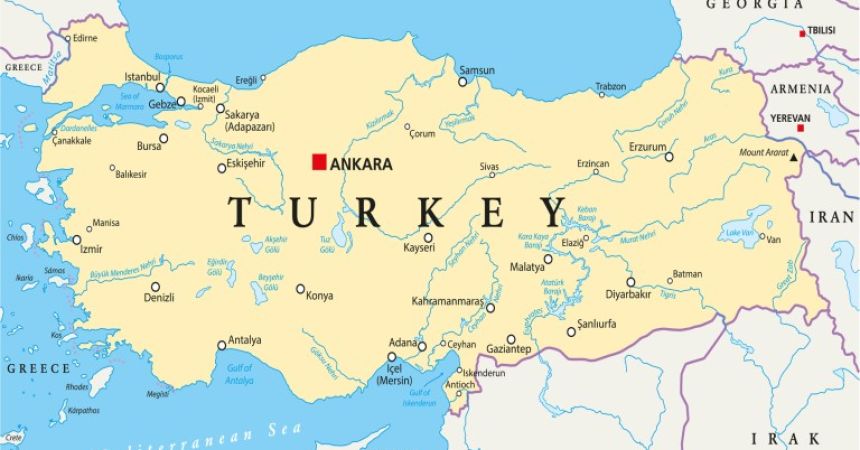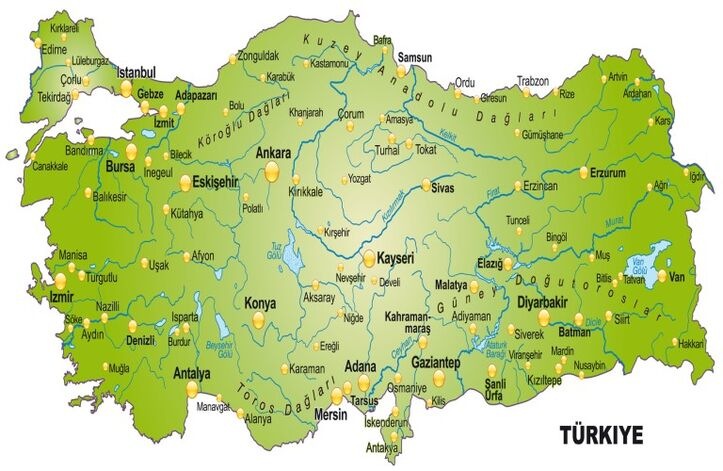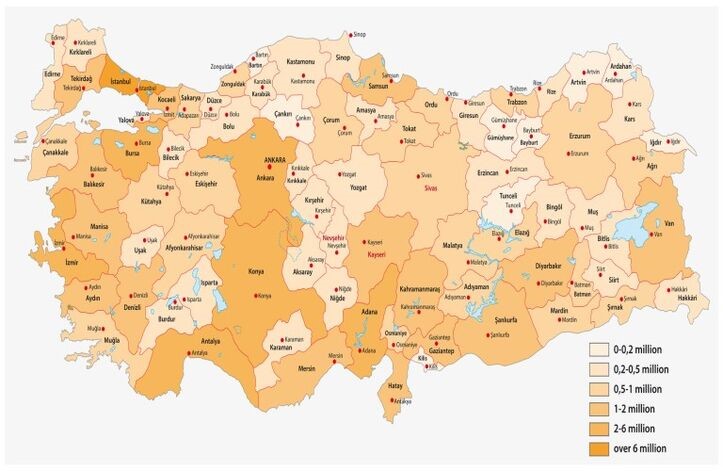
Map Of Turkey
Introduction to the Map of Turkey
Turkey, a transcontinental marvel bridging Europe and Asia, offers a rich tapestry of landscapes, cultures, and histories that leave every visitor awestruck. The map of Turkey is a testament to its diversity, showcasing bustling cities, vast coastlines, towering mountains, and endless plains. From the ancient streets of Istanbul to the surreal landscapes of Cappadocia, every corner of this country holds a story waiting to be discovered.
In this blog, we’ll dive into the geography of Turkey, explore its key regions, and provide insights on how the map shapes its travel and cultural experiences.
Understanding Turkey's Geographical Layout
Turkey is uniquely positioned at the crossroads of Europe and Asia, separated by the Bosphorus Strait. Covering approximately 783,356 square kilometers, it is bordered by eight countries and surrounded by four seas:
- Black Sea to the north
- Aegean Sea to the west
- Mediterranean Sea to the south
- Sea of Marmara connecting the Black and Aegean Seas
The country is divided into 81 provinces, each with distinct characteristics. Its diverse topography includes coastal plains, fertile valleys, rugged mountains, and steppe-like plateaus.
Key Regions on the Map of Turkey
Turkey's geography is traditionally divided into seven regions, each offering unique landscapes and cultural experiences:
Marmara Region of Turkey
-
- Location: Northwestern Turkey, straddling Europe and Asia.
- Highlights:
- Istanbul: The cultural and historical heart.
- Bursa: Famous for its Ottoman heritage.
- Visit Gallipoli and Troy: Sites of historical significance.
- Features: Rolling hills, fertile lands, and the Sea of Marmara.
Aegean Region of Turkey
-
- Location: Western coastline.
- Highlights:
- Izmir: A vibrant coastal city.
- Ephesus: Ancient ruins showcasing Roman grandeur.
- Pamukkale: Natural travertine terraces.
- Features: Mediterranean climate, olive groves, and pristine beaches.
Mediterranean Region of Turkey
-
- Location: Southern Turkey.
- Highlights:
- Antalya: The "Turkish Riviera."
- Fethiye: Known for Ölüdeniz and paragliding.
- Aspendos: Ancient amphitheater.
- Features: Warm climate, turquoise waters, and rugged mountains.

Central Anatolia of Turkey
-
- Location: Heart of Turkey.
- Highlights:
- Ankara: The capital city.
- Cappadocia: Fairy chimneys and hot air balloons.
- Konya: The city of Rumi and whirling dervishes.
- Features: Steppe landscapes and ancient trade routes.
Eastern Anatolia in Turkey
-
- Location: Easternmost part of Turkey.
- Highlights:
- Mount Ararat: Legendary resting place of Noah’s Ark.
- Van Lake: Turkey’s largest lake.
- Ani: Medieval Armenian city ruins.
- Features: High-altitude plateaus and cold winters.
Southeastern Anatolia in Turkey
-
- Location: Bordering Syria and Iraq.
- Highlights:
- Göbeklitepe: The world’s oldest temple.
- Gaziantep: Culinary capital.
- Mardin: Known for its stone architecture.
- Features: Semi-arid climate and historical Silk Road sites.
Black Sea Region of Turkey
-
- Location: Northern Turkey.
- Highlights:
- Trabzon: Gateway to the Sumela Monastery.
- Rize: Lush tea plantations.
- Amasya: Historic Ottoman town.
- Features: Dense forests, mountainous terrain, and a rainy climate.
Major Cities on the Map of Turkey
Istanbul
-
- Spanning two continents, Istanbul is a city where ancient and modern converge. Landmarks like the Hagia Sophia, Topkapi Palace, and the Grand Bazaar are mapped as essential stops for any traveler.
Ankara
-
- The capital city, centrally located in Anatolia, is known for Atatürk’s Mausoleum and the Museum of Anatolian Civilizations.
Izmir
-
- A port city on the Aegean coast, known for its vibrant culture and proximity to Ephesus and Pergamon.
Antalya
-
- Nestled along the Mediterranean, Antalya offers both historical ruins and luxurious beach resorts.
Cappadocia (Nevsehir)
-
- Central Turkey’s treasure, marked by its surreal landscape of fairy chimneys and underground cities.
Cultural Insights Through the Map
Turkey’s map is not just geographical but also cultural, with regions reflecting diverse traditions:
- Cuisine: The southeast is famous for kebabs and baklava, while the Black Sea is known for anchovies and corn-based dishes.
- Languages and Dialects: Turkish is the official language, but Kurdish and Arabic are widely spoken in the southeast.
- Religion: Islamic heritage dominates, with stunning mosques marked on maps in every region.
Traveling Through Turkey with a Map
- Road Trips
- A road trip from Istanbul to Ephesus along the Aegean coast or from Ankara to Cappadocia offers unforgettable scenery.
- Hiking and Nature
- Maps guide adventurers through trails like the Lycian Way in the Mediterranean or the Kaçkar Mountains in the Black Sea region.
- Historical Routes
- Following the map to sites like Troy, Pergamon, and Göbeklitepe takes travelers on a journey through time.
Digital Maps and Tools
Modern tools like Google Maps and navigation apps make exploring Turkey easier than ever. These tools:
- Provide real-time updates on traffic and public transport.
- Highlight lesser-known attractions like hidden beaches and local eateries.
- Offer offline options for remote areas like Eastern Anatolia.

Key Tips for Navigating Turkey’s Map
- Plan Ahead: Turkey’s vastness requires careful planning. Allocate time to explore specific regions.
- Understand Distances: Cities like Istanbul and Antalya are far apart; flights may be necessary.
- Seasonal Considerations: Coastal areas are best in summer, while Cappadocia and Eastern Anatolia shine in spring and autumn.
Explore the Detailed Map of Turkey
The map of Turkey is more than just a tool for navigation—it’s a window into the soul of a country rich in culture, history, and natural beauty. Whether you’re tracing ancient trade routes, relaxing on Mediterranean beaches, or exploring bustling bazaars, every journey through Turkey begins with its map.
So, grab a map, chart your course, and get ready to uncover the wonders of Turkey, one region at a time.



